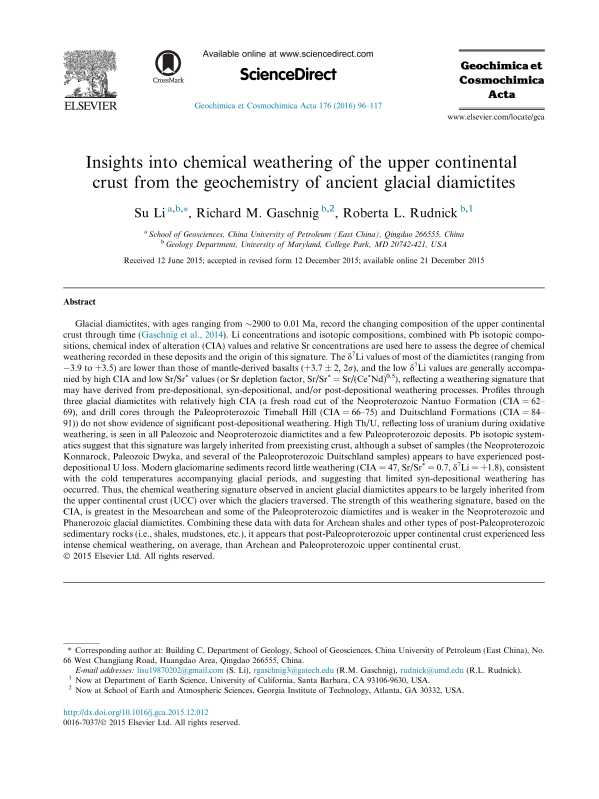Su Li, Richard M. Gaschnig, Roberta L. Rudnick
Insights into chemical weathering of the upper continental crust from the geochemistry of ancient glacial diamictites
Geochimica et Cosmochimica Acta,
Volume 176, 2016, Pages 96-117, ISSN 0016-7037,
https://doi.org/10.1016/j.gca.2015.12.012
Abstract: Glacial diamictites, with ages ranging from ∼2900 to 0.01Ma, record the changing composition of the upper continental crust through time (Gaschnig et al., 2014). Li concentrations and isotopic compositions, combined with Pb isotopic compositions, chemical index of alteration (CIA) values and relative Sr concentrations are used here to assess the degree of chemical weathering recorded in these deposits and the origin of this signature. The δ7Li values of most of the diamictites (ranging from −3.9 to +3.5) are lower than those of mantle-derived basalts (+3.7±2, 2σ), and the low δ7Li values are generally accompanied by high CIA and low Sr/Sr∗ values (or Sr depletion factor, Sr/Sr∗=Sr/(Ce∗Nd)0.5), reflecting a weathering signature that may have derived from pre-depositional, syn-depositional, and/or post-depositional weathering processes. Profiles through three glacial diamictites with relatively high CIA (a fresh road cut of the Neoproterozoic Nantuo Formation (CIA=62–69), and drill cores through the Paleoproterozoic Timeball Hill (CIA=66–75) and Duitschland Formations (CIA=84–91)) do not show evidence of significant post-depositional weathering. High Th/U, reflecting loss of uranium during oxidative weathering, is seen in all Paleozoic and Neoproterozoic diamictites and a few Paleoproterozoic deposits. Pb isotopic systematics suggest that this signature was largely inherited from preexisting crust, although a subset of samples (the Neoproterozoic Konnarock, Paleozoic Dwyka, and several of the Paleoproterozoic Duitschland samples) appears to have experienced post-depositional U loss. Modern glaciomarine sediments record little weathering (CIA=47, Sr/Sr∗=0.7, δ7Li=+1.8), consistent with the cold temperatures accompanying glacial periods, and suggesting that limited syn-depositional weathering has occurred. Thus, the chemical weathering signature observed in ancient glacial diamictites appears to be largely inherited from the upper continental crust (UCC) over which the glaciers traversed. The strength of this weathering signature, based on the CIA, is greatest in the Mesoarchean and some of the Paleoproterozoic diamictites and is weaker in the Neoproterozoic and Phanerozoic glacial diamictites. Combining these data with data for Archean shales and other types of post-Paleoproterozoic sedimentary rocks (i.e., shales, mudstones, etc.), it appears that post-Paleoproterozoic upper continental crust experienced less intense chemical weathering, on average, than Archean and Paleoproterozoic upper continental crust.


